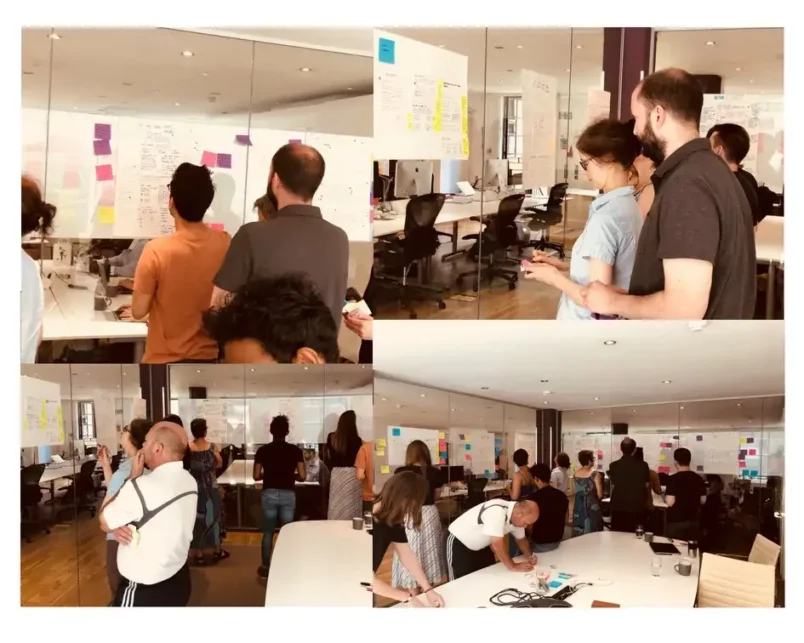
Can a design sprint help people living with a life-changing illness?

We came up with the following:
- Can we create the right balance between emotional, clinical and practical support?
- To what extent does our solution need to be condition / symptom specific?
- Can we find the right balance between curation and signposting?
Sketching some solutions
The next step of the process involved the four-step sketch process where we were able to quickly capture notes and start sketching our ideas on paper.
The ideas in these solution sketches would become the foundation of our prototype to be tested by the end of the sprint week.

What was interesting was that each of our ideas contained similar themes — most contained a ‘peer support’ element, a manifestation of the finding that people diagnosed with a life-changing illness and their carers could greatly benefit from being able to discuss their situation with someone going through a similar experience.
Deciding on a direction
After a busy morning of reviewing and voting on which sketches we thought would best help us answer our sprint questions and achieve our goal, we invited in some experts to help challenge some of our decisions and the direction we were taking.
Many thanks to the time taken by various people, we were able to get valuable feedback from a GP, oncologist, specialist palliative care nurse, and services operations manager from a well known cancer care charity.

Prototyping our solution
The solution that we chose to focus on was three fold:
- Helping people prepare for appointments
- Giving people a step-by-step guide to help them navigate their illness
- Providing a ‘peer support’ element through relevant shared experience
We built our prototype using Google Slides and InVision in a single day, creating a high fidelity clickable website ready for people to test the next day.

Testing our prototype
For our testing day we’d organised for 5 people to come in and test out prototype in person. These were people who were directly affected by a life-changing diagnosis.

We had two people interviewing and the rest of the sprint team watching remotely in another room. This let the interviewer focus on walking the user through the prototype, making sure no bits were missed, while the team made notes and pulled out all the insight from each interview.
So what did we learn from the design sprint?
There were a few key insights to come out of our testing on Friday. Some were actually slightly unexpected and we’ll want to dig a bit deeper into some of these in the coming months.
- People really valued ‘peer support’ or shared experience
We factored the ‘I’ve been there’ angle into most sections of our prototype — which went down well with our testers, they liked seeing that there were others in their situation. We also know from interviewing Garry in our discovery phase that peer support can take many forms, online and face-to-face.
We want to explore this further — in what different ways can we introduce peer support to people in the context of people being diagnosed with life-changing illness? Could we staff our information line with team members who have a broad range of personal experience so when people phone looking for information we are able to provide peer support led advice and guidance?
- People liked the ability to talk to someone (just not in the way we thought)
What was fascinating here was that ‘live-chat’ was mentioned independently by a few people as a way they’d like to get in touch and ask questions — as an organisation who provide a free telephone information line this was a really interesting insight into the way people want to access information.
This also mirrors people’s desire to speak to a real person, as we so often hear on our current information line — knowing that there is a real person at the end of the phone makes all the difference to someone who needs support and reassurance.
- People liked the idea of preparing for appointments
We thought people would like this section of our prototype, and the feedback from testing confirmed this. We knew though that a webpage doesn’t go quite far enough in enabling people to prepare. We know from our desk research that solutions already exist in this area, so we’ll be keen to explore this a bit further by talking to Mindwave and Healthdirect — two tools which help people prepare for appointments.
Next steps
After a week reflecting on our results, we’ve agreed that whilst we’ve built a prototype which was received well by our testers there were some findings which we definitely need to explore further.
We need to do some more research looking into the role peer support can play in addressing people’s needs — would providing peer support led team members better serve the needs of people with a life-changing diagnosis?
Also, the format in which people access information is an area which we want to explore in more depth — the live-chat finding from our testing threw us a bit, so we need to explore how this would work in practice. Would someone newly diagnosed ask a different question on live-chat than face-to-face for example?
Finally, with the Sprint process itself it was great to find out just how quickly we can put a prototype together — knowing this, we are quite comfortable with the idea of ‘changing tack’ to explore a few more different things and creating some new prototypes in the coming months.
Watch this space!
If you’re interested in finding out a bit more about our sprint findings, get in touch — tweet or email me.